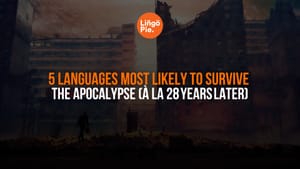Most people can tell you random language trivia, like which language has the longest word in the world, but ask them about the oldest spoken languages, and you'll get blank stares. Yet some of the languages people speak today have roots stretching back thousands of years, surviving empires, migrations, and countless cultural shifts.
What makes a language truly ancient? And more importantly, which ones have managed to stay alive while others faded into history? The answers might surprise you, especially when you realize you've probably heard some of these ancient languages without even knowing their incredible age. Let's get to know them below, shall we?
- Language Difficulty Ranking For English Speakers [Study]
- 7 Reasons Why You Should Learn A Language Through Stories
- What Languages Are Spoken In Singapore? 4 Must-Know Languages

What Is The Oldest Language In The World?
Sumerian is the oldest language in the world, originating around 3100 BCE in ancient Mesopotamia. It was the first language written in cuneiform script and has the oldest clear written records we can actually prove.
The problem is Sumerian died out completely. Since there's no way to prove what the first spoken language was, most linguists go with the oldest written evidence, which makes Sumerian the winner by default.
What Is The Oldest Written Language?
Sumerian cuneiform is the oldest writing system in the world, created around 3100 BCE. The oldest complete sentence ever written is actually in Egyptian hieroglyphs from 2690 BCE, but Sumerian had a longer development period from simple symbols to full writing.
So Sumerian wins for oldest writing system, Egyptian wins for oldest complete sentence.
What Is The Oldest Surviving Language In The World?
Greek is the oldest surviving language, with documented history going back to at least 1450 BCE. It's been continuously spoken for over 3,400 years and still has 13.5 million native speakers today.
Tamil comes in second, with confirmed records from 300 BCE, though Tamil speakers claim their literature goes back much further. Greek wins because it has older documented proof and has never stopped being a living, everyday language.
The Oldest Languages in the World
1. Tamil
Tamil is a Dravidian language. This is a group of languages spoken by 250 million people, mainly in southern India, northeast Sri Lanka, and southwest Pakistan.
It is hypothesized to be around 5000 years old, however, the earliest written account of Tamil only dates back 2500 years. The ancient Tamil literature from 500 BCE indicates a maturity that suggests Tamil existed in its written form long before this date.
Many scientists speculate that Tamil is the world's oldest language, but there is no way to be sure of this as humans started speaking anywhere between 100,000 and 200,000 years ago. We do not have the written evidence to know for sure.
There are around 70 million native speakers of the Tamil language today, and they mostly reside in Southern India and Sri Lanka.
2. Sanskrit
Sanskrit is a classical language from the Indo-Aryan branch of the Indo-European Languages. It originated in South Asia in the Bronze Age after its predecessor languages filtered down the continent from the north.
Sanskrit is the holy language found in the scriptures of Hinduism, Buddhism, and Jainism. The oldest incarnation of this language is Vedic Sanskrit.
The ancient Hindu Vedic Sanskrit hymns known as the Vedas were composed around 1500 BCE and orally preserved for centuries before the invention of the written language.
The first written record of these texts was found in Nepal and dates back to 1040 CE. This suggests the Vedas were impeccably preserved by the oral tradition for millennia.
Today, only around 14,000 people speak Sanskrit as their mother tongue.
3. Egyptian
While modern Egyptians speak Arabic, the current form of the ancient Egyptian language known as Coptic is still in use as a liturgical language within the Coptic Church.
Today’s Coptic language is not the same as Archaic Egyptian. However, since Coptic is the direct descendant of Archaic Egyptian, some people would argue this makes Coptic the oldest spoken language in the world.
Ancient Egyptian, now a dead language, is one of the longest-attested human languages, with a history spanning 4000 years. Egyptian Hieroglyphics date back to 3300 BCE.

4. Hebrew
Hebrew is a Northwest Semitic language from the Afroasiatic language family. This language dates back to around 3200 BCE. Hebrew was largely preserved throughout history as the main liturgical language of Judaism.
From the 2nd century CE, Hebrew was not spoken as a mother tongue but kept alive in liturgical writing and practices. It is the best example of a dead language that was successfully revived. In the late 19th century, Jews from diverse regions began arriving in Palestine and re-establishing Hebrew as the main spoken language for daily life.
Hebrew, as well as English and Arabic, became the official language of British-ruled Palestine after the first World War. It is also the official language of Israel and has 9 million speakers today.
5. Latin
Italy is the birthplace of Latin and it is part of the Indo-European language family. The earliest form of Latin that we know of is Old Latin, which was spoken from the Roman Kingdom, around 750 BCE, to the Roman Republic period, which ended in 27 BCE.
This language was replaced by literate Classical Latin, which was used by orators, poets, and historians, and spoken Vulgar Latin. Vulgar Latin was the language of the common people during the Roman Empire, and dialects of this language became the modern-day Romance languages.
Latin was the lingua franca of scholars until the 18th century. It is now considered a dead language, as it has no native speakers. However, many students around the world still study Latin and it is used in some Catholic masses.
Related:

6. Greek
Ancient Greek incorporates various forms of the Greek language used between 1500 BCE to 300 BCE. Mycenaean Greek is the oldest attested form of the Greek language, spoken between the 16th and 12th centuries BCE.
This form of Ancient Greek is preserved in the inscriptions on clay tablets of Linear B, a script written in the 14th century BCE, predating the Greek alphabet by centuries.
The Ancient Greek of the Dark Ages is the language of Homer, born in the 8th century BCE, the author of the Iliad and the Odyssey. Homer is regarded as one of the most influential writers of all time and these works still hold great importance in modern-day literature.
Like Latin, Ancient Greek is a dead language, but it still holds importance in the world of academia and is studied across the world.

7. Farsi
Farsi, also known as the Persian language, is a Western Iranian language that belongs to the Indo-Iranian subdivision of the Indo-European languages. It is predominantly spoken in Iran, Afghanistan, and Tajikistan.
Old Persian is one of the oldest Indo-European languages attested in original texts. The language is hypothesized to date back to the first millennium BCE.
The oldest example of Farsi-written script is the Behistun Inscription by Darius I (522–486 BCE), the third ruler of the Achaemenid Persian Empire.
Today, there are around 70 million speakers of Persian as a native language and 110 million total speakers.
8. Irish
Also known as Gaelic, the Irish language was brought to Ireland by the Celts. This ancient tribe arrived around 500 BCE and slowly spread across the country. By the 5th century CE, Gaelic was spoken all over Ireland.
Primitive Irish scripts from the 4th century CE are written in Ogham, an early medieval alphabet. Now, Irish is written in the Latin alphabet.
There are around 1.2 million speakers of Irish today, but only 170,000 people speak it as a first language. English and Irish are the official languages of the Republic of Ireland, with Irish being the first official language. Northern Ireland has no official language.
The Irish language is related to Manx, Scottish Gaelic, Welsh, Cornish, and Breton languages.
9. Arabic
Arabic is a Semitic language of the Afroasiatic family. It arose in the 1st century CE and is named after the Arab people; those living in the Arabian peninsula, a geographical region perceived by Ancient Greeks.
The earliest attested written records of Arabic are three lines of poetry by a man called Garm(')allāhe from 125 CE. This text was found in Israel.
The Arabic language is a very widely spoken language, with 313 million speakers worldwide.
10. Chinese (Mandarin)
Chinese is part of the Sino-Tibetan language family. The origins of the Chinese language are hypothesized to date back 6,000 years. However, the writing system did not develop until centuries later, so much of the history of this language is unknown.
The first known use of the Chinese writing system is inscriptions in tortoise shells and oracle bones from the Shang dynasty (1766–1122 BC). There are over 100,000 Chinese characters in existence, but you only need to know around 2,000 to read a newspaper.
Chinese has 1.3 billion speakers, making it the most spoken language by natives in the world.
Related:


Want To Learn A New Language?
Hopefully, this breakdown of some of the oldest languages in the world has opened your eyes to the incredible history of human oral and written tradition, the fascinating way languages evolve over time, and the importance of language preservation.
While we do not know for sure which is actually the oldest known language, those listed above are generally considered to be the most ancient. If you want to learn other languages, visit Lingopie. This streaming service is home to TV shows and movies in French, Spanish, Italian, Portuguese, German, Russian, Japanese, and Korean. You can get started with a 7-day free trial today!
FAQs: The Oldest Languages in the World
Which is the first language in the world?
The concept of the "first language in the world" is complex and debated among linguists. While no definitive answer exists, many scholars believe that languages like Sumerian, spoken in Mesopotamia around 3500 BC, and Egyptian, used around the same period, are among the earliest known written languages.
What was the first language to speak?
The first spoken language is difficult to determine because speech leaves no direct archaeological evidence. However, it is believed that early humans began developing complex spoken languages over 100,000 years ago. These early languages likely evolved in Africa, where human civilization began.
Is Tamil or Sanskrit older?
Both Tamil and Sanskrit are ancient languages, but Tamil is generally considered older in terms of its continuous use. Tamil has a recorded history dating back over 2,000 years, with classical literature that is among the oldest in the world. Sanskrit, though ancient and classical, became prominent slightly later, with the earliest Vedic texts dating to around 1500 BC.
Do people still learn ancient languages?
Yes, dead ancient languages such as Greek and Latin are still studied today. Moreover, many ancient living languages such as the Armenian language, the Aramaic language, and those above-listed have millions of speakers.










![Qixi Festival Guide: Meaning, Traditions, and Chinese Love Vocabulary [Guide]](/blog/content/images/size/w300/2025/06/Qixi-Festival-Guide.jpg)